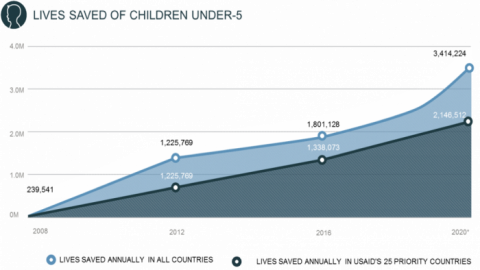- Home
- Agencies
- Department of Agriculture
- Department of Housing and Urban Development
- General Services Administration
- Department of Commerce
- Department of the Interior
- National Aeronautics and Space Administration
- Department of Defense
- Department of Justice
- National Science Foundation
- Department of Education
- Department of Labor
- Office of Personnel Management
- Department of Energy
- Department of State
- Small Business Administration
- Environmental Protection Agency
- Department of Transportation
- Social Security Administration
- Department of Health and Human Services
- Department of the Treasury
- U.S. Agency for International Development
- Department of Homeland Security
- Department of Veterans Affairs
- Goals
- Initiatives
- Programs
The End of Preventable Child and Maternal Deaths is in Sight
What’s the issue?
Over the past two and a half decades, the world has reduced child mortality by more than half, and maternal mortality by nearly as much. This means that 18,000 more children and 650 more mothers will survive today, than each day in 1990. Despite this progress, 5.9 million children under-5 still die each year, almost 1 million of them on their first day of life, and 303,000 women die annually during what should be one of the happiest days in their life. The vast majority of these deaths are caused by complications and illnesses for which there are known, affordable treatments.
What was the intervention?
In response, United States Agency for International Development (USAID) has set a goal to end preventable child and maternal deaths within a generation. USAID is working toward this goal both through ensuring our programs have the greatest impact as well as leveraging our position as a global leader in development.
USAID focuses on ending preventable child and maternal deaths (EPCMD) in the following 25 priority countries: Afghanistan, Bangladesh, Burma, Democratic Republic of Congo, Ethiopia, Ghana, Haiti, India, Indonesia, Kenya, Liberia, Madagascar, Malawi, Mali, Mozambique, Nepal, Nigeria, Pakistan, Rwanda, Senegal, South Sudan, Tanzania, Uganda, Yemen, and Zambia. These were chosen based on highest need, demonstrable commitment, and the greatest opportunity to save lives. In priority countries, we are working with national governments, partners, civil society, and faith based organizations to support national health plans and improve access to quality services for women and children.
Because on the ground we are working with one woman, or one family, that likely receives care at one clinic, our efforts to end preventable child and maternal deaths include collaboration across multiple health sectors and include investments in:
- Voluntary family planning
- High quality and respectful care during pregnancy, labor, and delivery
- Newborn health, including addressing breathing problems at birth, complications of preterm delivery, and severe bacterial infections
- Routine immunization for children
- Diagnosis and treatment for common childhood illnesses, such as diarrhea and pneumonia
- Prevention and treatment of malaria in pregnant women and children
- Access to a safe water supply, sanitation, and hygiene
- Addressing the root causes of undernutrition
USAID has also played a significant role in mobilizing global attention to ending preventable child and maternal deaths. In 2012, USAID hosted a Call to Action to unite governments and partners around this achievable goal. Since then, 19 of our 25 priority countries have launched sharpened country strategies and scorecards to track progress. In part due to our leadership, key maternal and child health indicators are now included in the global Sustainable Development Goals.
How was performance management useful?
USAID made ending preventable child and maternal deaths an Agency Priority Goal for every goal period. USAID releases an annual Acting on the Call report, which reports on key indicators and tracks annual progress against high performing countries. The report also systematically assesses each priority country and uses modeling to indicate which interventions will have the greatest impact. By making this vision public and transparently reporting on indicators and progress, the Agency has been able to renew energy towards achieving this goal.
What was the impact?
For the first time, USAID and its partners are equipped with the tools and knowledge to reach this goal. Since 2008 alone, USAID efforts have contributed to saving the lives of 4.6 million children and 200,000 women by improving access to high quality health services for women and children in 25 countries around the world. Between 2008 and 2015, the percentage of women giving birth in a health facility in EPCMD priority countries rose from 42 percent to 54 percent , which helped the neonatal mortality rate decrease 18.5 percent in the same window. In EPCMD priority countries, DPT3 coverage, a common indicator in the strength of a routine immunization system, increased from 71 percent in 2008 to 81 percent in 2016. In USAID’s nutrition priority countries, stunting prevalence –a key measure of child undernutrition– was reduced from 41 percent in 2008 to 34 percent in 2016. In the EPCMD priority countries receiving family planning assistance, the modern contraceptive prevalence rate increased from 25 percent in 2008 to 33.6 percent in 2016. USAID’s malaria projects continue to scale-up insecticide-treated nets (ITNs), indoor residual spraying (IRS), appropriate malaria case management including diagnosis and treatment with artemisinin-based combination therapies (ACTs), and intermittent preventive treatment of malaria in pregnancy (IPTp). ITN scale-up alone protected over 72 million people in FY 2015. As a result of USAID’s support to malaria programs and coordination with other major donors including the Global Fund, the World Bank, and UNICEF, 17 of the 19 President’s Malaria Initiative (PMI) focus countries in Africa with paired nationwide surveys show significant declines in all-cause mortality rates among children less than five years of age, ranging from 8 percent to 67 percent.





